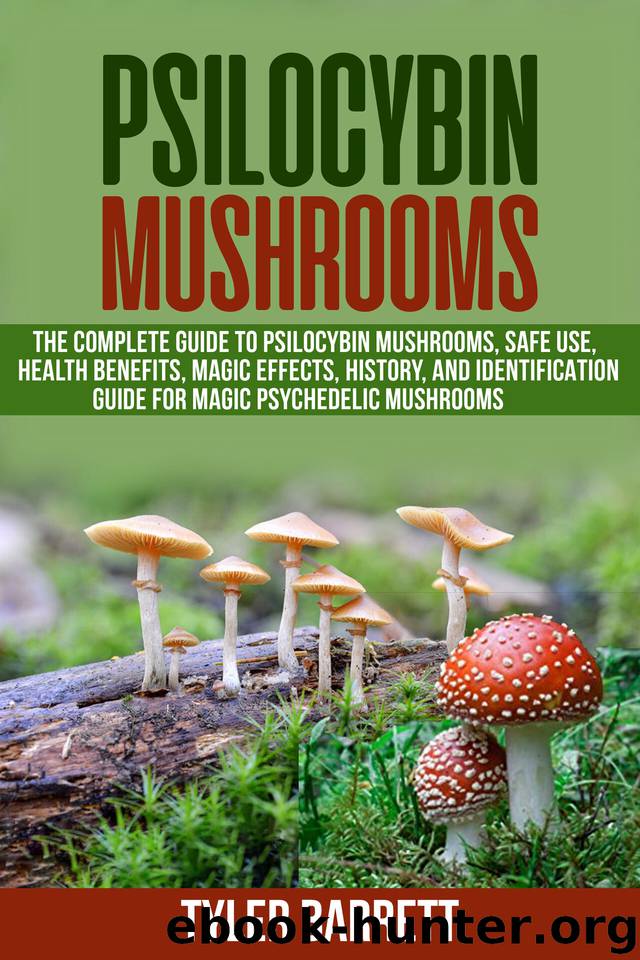Psilocybin Mushrooms: The Complete Guide to Safe Use, Health Benefits, Magic Effects and History of Magic Mushrooms by Tyler Barrett

Author:Tyler Barrett [Barrett, Tyler]
Language: eng
Format: azw3
Published: 2020-05-25T16:00:00+00:00
Chapter 8
Psllocybe: The Species
T here are some thirty thousand documented mushroom-producing fungi species around the world. Of these, it is known that around a hundred species or varieties contain psilocybin or related compounds. Most of these are found in the genera Psilocybe and Panaeolus, with some other genera appearing in Inocybe, Conocybe, Gymnopilusland. Not every species in these genera, of course, contains psilocybin, and even those who do may produce it in trace amounts only. We present methods for the cultivation of two types of psilocybin mushrooms in this book: the coprophilic (or dung-inhabiting) species Psilocybembensis, and the interrelated lignicolous (wood-inhabiting) species complex such as Psilocybeazurescens and P. cyanescens.
For several important reasons, we have chosen to focus on these particular species: they produce psilocybin in relatively high quantities, they have a long cultivation history and they fruit reliably under easily reproducible conditions. Additionally, they offer indoor (with P. cubensis) and outdoor (with any of the species in the P. azurescens complex) cultivation options. While there are certainly other well-known species which also meet these criteria, for any diligent grower the two types we have chosen should produce ample quantities of psilocybin. The goal of this chapter is to familiarize you with these animals, including their natural habitat, distribution, and behaviour, so you will understand their basic biology when you begin to work with them. This book is not meant to be a "field guide" and does not train you to identify and collect these wild species.
Foraging mushrooms, whether for food or psilocybin, requires a great deal of skill and knowledge. It is a true and potentially lethal danger to become contaminated as a result of misidentification. If you are interested in collecting your own mushrooms, we suggest you familiarize yourself with at least several good field guides (we've listed several excellent North American fungi guides in Appendix C) and consult with experts who already know your area's fungi directly. Chances are you have a local mycological club or society, where people can teach you what you need to know to identify wild mushrooms. Paul Stamets Psilocybin Mushrooms, if the Vl-orld is currently the most comprehensive text on the subject, is an essential addition to any mycology library for further reading about the many psilocybin-containing mushrooms found worldwide.
Psilocybecubensis
Psilocybecubensis is the most generally cultivated species of psychoactive mushrooms, for both recorded and biological reasons. Worldwide, it is one of the most widely recognized psilocybin containing species found in the wild, and subsequently among the most normally consumed and most notable. It is Psilocybecubensis fruiting from a plate of cased wheat berries. Additionally, one of the easiest to cultivate, since it fruits on a wide scope of substrates, and under an assortment of natural conditions. In spite of the fact that in the wild it grows solely on dung, under cultivation it will organic product from pretty much any substrate adequately high in carbon and nitrogen: oat straws, grains, grasses, com, even from wood, paper, or cardboard, whenever enhanced with some form of protein.
Download
This site does not store any files on its server. We only index and link to content provided by other sites. Please contact the content providers to delete copyright contents if any and email us, we'll remove relevant links or contents immediately.
| Comparative | Conflict of Laws |
| Customary | Gender & the Law |
| Judicial System | Jurisprudence |
| Natural Law | Non-US Legal Systems |
| Science & Technology |
Future Crimes by Marc Goodman(3002)
American Kingpin by Nick Bilton(2972)
The Meaning of the Library by unknow(2069)
Inside the Middle East by Avi Melamed(1940)
On Tyranny by Timothy Snyder(1860)
Why Nations Fail: The Origins of Power, Prosperity, and Poverty by Daron Acemoglu & James Robinson(1787)
Living Silence in Burma by Christina Fink(1729)
Putin's Labyrinth(1656)
The Mastermind by Evan Ratliff(1591)
Think Like a Rocket Scientist by Ozan Varol(1397)
Law: A Very Short Introduction by Raymond Wacks(1383)
The Smartest Kids in the World by Amanda Ripley(1368)
Leadership by Doris Kearns Goodwin(1349)
The Rule of Law by Bingham Tom(1318)
A Dirty War by Anna Politkovskaya(1314)
It's Our Turn to Eat by Michela Wrong(1301)
Philosophy of law a very short introduction by Raymond Wacks(1297)
Social Media Law in a Nutshell by Ryan Garcia & Thaddeus A Hoffmeister(1249)
Civil Procedure (Aspen Casebooks) by Stephen C. Yeazell(1175)
